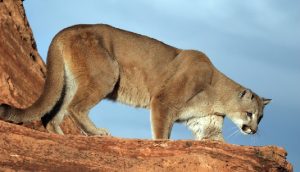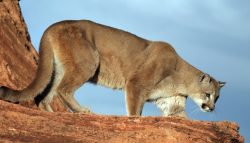Puma, Panther, Cougar. . . Lion!
“Close enough to hear them purr”

By LARRY JOSEPH CALLOWAY (C)
Mountain lions live here in the Sangre de Cristo mountains of Colorado. So you’d think Ron Garcia would not be surprised to see one. He’s the longtime manager of the Baca National Wildlife Refuge five minutes from Crestone, and lions are, of course, wildlife. They are unmistakable, with adult males about eight feet long from nose to tail tip and females a foot shorter.
Yet, one evening a few years ago as he left work at the historic ranch headquarters of the refuge Garcia was very surprised. First he noticed a barn door was open. He got out of his truck to close it. The winter shadows were long. Suddenly he saw something move in the dark at the base of a barn wall. It was a full grown lion lying in wait.

Not waiting for Garcia, who instinctively reached for a pistol he wasn’t carrying. He knew mountain lions eat deer almost exclusively, and this one likely was waiting for the deer that wander into the cottonwoods at the headquarters — and nowhere else on the flat, watery refuge. It has an over-population of about 3,000 elk, but they are not the natural prey of lions, whose normal habitat is higher ground — beginning with the pinyon-juniper belt where most us live.
There is no record of fatal attacks on people here. And though occasionally a lion will kill a small mammal, in Garcia’s view pets are safe. “Taking a small dog is rare. If they attack one it’s more from fear or hunger.” With all the deer wandering in the Baca subdivision and in town, there shouldn’t be starving lions around.
Anyway, the shadowy lion by the barn that evening padded softly away. (Like this: Garcia showed with his hands like paws.) It was not seen again, and lions are seldom seen on the refuge generally. “Typically when you see one in the flats there’s an issue with the animal — usually a health issue — because the animal is out of its element. It’s the same thing with bears,” he said.
District game warden James Romero, a 15-year veteran of the department, said he has not received a call about a mountain lion since he transferred to his native San Luis Valley a year ago. “They prefer seclusion and want to be left alone as much as possible,” he said. “Their mode is not to attack people.”
Still, he recommended the brochure “Living With Lions,” which can be downloaded from the Parks and Wildlife web site. The main advice is don’t be out alone in lion country, especially at dawn or dusk, and when out with children keep them within arm’s reach. There are 4,500 to 5,500 wild lions in Colorado.
My own research showed that of the rare 14 fatal lion attacks in North America since 1970 six victims were children and most of the adults were jogging, skiing, biking or hiking alone. Speeding through lion country without paying attention to your surroundings can trigger the chasing instinct. Lions usually attack by leaping from behind and severing the thoracic spine with teeth that have evolved in the balance of nature especially for deer.
Matthew Crowley of Shumei International Center says new visitors there, particularly young people from Japan, are informed they are in mountain lion country and that they should walk in pairs and “never run” if they happen to see a big cat. “It’s not fear,” he said. “It’s respect. Living where we do it’s awesome that we have mountain lions around.”
Last winter Bill Aldinger, who cooks at the Haidakhandi Universal Ashram just down the road from Shumei, saw a lion. He walks to work up Spanish Creek road, and one morning he noticed a pair of deer antlers sticking out of the snow near the intersection with Camino Baca Grande. Based on his five seasons on fire crews in Idaho he said to himself, “Cat,” and did not investigate.

Next morning as he trudged to work with his head down he looked up and saw a lion feeding on the buck deer in the snow. “I made myself tall, and he looked up at me and I looked at him. I thought, ‘Just stand here and don’t be afraid.’ I thought, ‘Am I really seeing this?’”
The eye-to-eye contact lasted only a few seconds, but it was memorable. Aldinger had seen lions in Idaho but, he said, “never this close.” He added, “I honor them and respect them, but I was not going to say, ‘Here, kitty, kitty.’” Suddenly the lion leapt away and disappeared.
The remains of the deer were reduced to scraps of fur as the chain of predators did their work by spring. And somebody took the six-point rack as a trophy.
Licensed hunters “harvested” 36 lions in the mountains around the San Luis Valley in 2014, the last year for which statistics are available, according to a spokesman for Parks and Wildlife.
The foremost scientific study of mountain lions (technically called cougars or the species puma concolor) was concluded 21 years ago in the San Andreas Mountains of New Mexico by the Hornacker Wildlife Institute, now located in Bozeman, Mont. Researchers tagged 241 cougars and monitored 126 by radio collars.
Without expressing any opinion about hunting, the 200-plus-page report nonetheless provided evidence to refute arguments that open cougar hunting seasons (Nov. 20 to March 31 this year in Colorado) serve any purpose apart from recreation and its contribution to the economy.
First, lion populations are self-managing. Dominant males, which can range 75 miles, are so aggressively territorial that they kill off any excess population — males, females and even cubs. Second, lions do not, according to this $1 million study for the New Mexico Game and Fish Department, prey upon cattle. The lion diet was calculated as 84 per cent deer. The remainder was antelope, rabbits, coyotes, skunks, small rodents, birds and reptiles but . . . . no beef.
The scientific researchers added a poetic note in the “acknowledgements” section:
“For 10 years we delved into the lives of cougars, sometimes getting close enough to hear them purr. Besides the observations we made to address our objectives, time and again we also observed cougars do things that we could attribute only to cognition and conscious thinking, characteristics that many of us humans normally reserve only for ourselves.
“To consider that we have some basic mental processes in common with cougars actually helped us be as objective in our observations and understanding of their life as was humanly possible. For those important lessons and for some of the most marvelous experiences of our lives, we are grateful to the cougars.”
(First published in the August edition of the Crestone Eagle)

